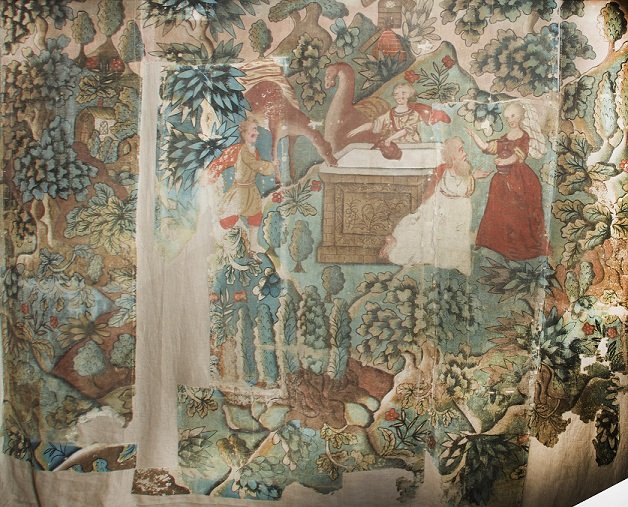
“my whole charge consists of ancients, corporals, lieutenants, gentlemen of companies, slaves as ragged as Lazarus in the painted cloth, where the glutton’s dogs licked his sores” Falstaff – Henry IV, Part I 4.2.
Today’s blog features a late seventeenth-century painted cloth, which most likely depicts the biblical story of the marriage of Rebecca and Isaac. This is a rare survival (due to its perishable material) of a once very common type of decoration that probably adorned the walls of William Shakespeare’s childhood home. Though sometimes mistakenly referred to today as “poor man’s tapestry”, painted cloths were a completely different type of decoration and could be found in houses belonging to people from different ranks in society, from homes as grand as Hardwick Hall in Derbyshire, to those as humble as a tradesman’s.

Once the cloth – canvas, or linen – was hung, a craftsman from the Painter-Stainer’s Guild was commissioned to apply the design directly onto the fabric. In addition to the few extant examples that we can admire today, evidence of the type of content seen on these objects survives in sources like Falstaff’s reference to the biblical parable of the Rich Man and Lazarus as the subject of painted cloths in Henry IV, Part I, and reminds readers today that the interiors of many Elizabethan and early Stuart homes were elaborately decorated. Further designs found on these cloths might include scriptural texts, proverbs, colorful patterns, or classical or biblical imagery. Robert Burton, in his popular book The Anatomy of Melancholy, jokingly recommended as an alternative to reading the classics such as “Seneca, Plutarch, Epictetus &c.”, to “consult with…painted cloathes”. Despite Burton’s sarcastic and slightly snobby remark, it was perhaps possible to “by a painted cloth be kept in awe” as indicated by Shakespeare’s poem The Rape of Lucrece.
This popular decorating style was not simply fashionable, but also functional, acting as a form of insulation intended to hopefully keep the heat in and the cold out. In addition to this practical utility, the images on painted cloths might serve to instruct, warn, encourage, and remind the observer; and functioned much like the Potiphar’s wife cushion from my previous post. In this particular instance, the subject of the marriage of Rebecca and Isaac almost certainly served to reinforce the ideals of a happy marriage.
